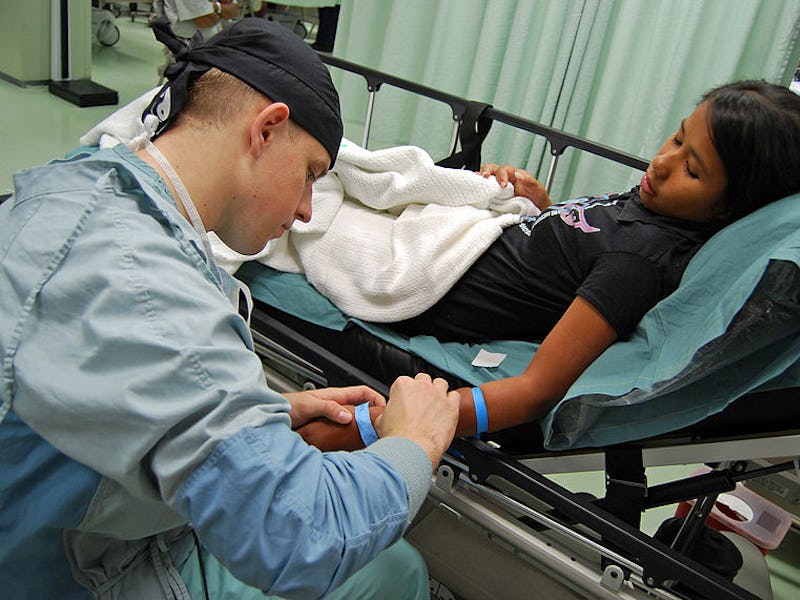Antibiotic Resistant Bugs Hang Out in These Hospital Blindspots
They're "cumbersome to change, disinfect, and clean."

One of the biggest threats to global health is also one of the greatest public health challenges in recent history. Antibiotic resistance is what happens when germs like bacteria and fungi evolve to defeat the drugs humans have designed to kill them. These changed bacteria are also known as multidrug-resistant organisms, and a new study reveals they are hiding out in an alarming location.
This weekend at the 29th European Congress of Clinical Microbiology & Infectious Diseases, researchers from the University of Michigan Medical Center will present evidence linking multidrug-resistant organisms (MDROs) to patient privacy curtains. These curtains, which are used in healthcare facilities around the world, are frequently touched and infrequently cleaned.
Study co-authors Lona Mody, M.D., and Kristen Gibson, M.P.H., tell Inverse that these curtains are “cumbersome to change, disinfect, and clean.” Their research demonstrates that, as a result, these curtains are contaminated with MDROs and that patients are frequently contaminated with the same MDROs as those found on their privacy curtains.
Whether the bacterium originated with the patient or curtain before infecting the other is a question that still needs to be answered.
Hospital curtains sometimes harbor dangerous bacteria.
“When we looked at this question using traditional microbiologic methods, we saw that transmission from patient to curtain was more common than from curtains to the patient,” Mody and Gibson told Inverse in a joint email. “This is a difficult question and one that merits more research and inquiry.”
The study evaluated bacterial culture samples from six skilled nursing facilities across southeast Michigan. The samples came from several sites on patient’s bodies and high-touch surfaces in their rooms, including the curtains. One sample was collected upon admission, then again after 14 days, then 30 days, and then monthly up to six months.
Overall, they gathered 1,521 samples from 625 rooms. Upon evaluation, they saw that 22 percent of the bacterial culture samples from privacy curtains tested positive for MDROs, with contamination rates varying across facilities.
The variety of MDROs in these samples were concerning: 13.8 percent were contaminated with vancomycin-resistant enterococci (VRE); 6.2 percent with resistant gram-negative bacilli (R-GNB); and 4.9 percent with methicillin-resistant Staphylyococcus aureus (MRSA).
Scanning electron micrograph of a MRSA.
The Centers for Disease Control and Prevention categorize two of these bugs, VRE and MRSA, as “serious threats.” Each year in the United States VRE cause 1,300 deaths and MRSA causes 11,285 deaths. Both bacteria commonly infect patients while they are in a healthcare setting.
“Drug-resistant organisms can cause infections that are difficult to treat simply because there are fewer antibiotics to treat them,” the researchers explain. “Often patients simply carry them without any consequence or infections, but then they go to other vulnerable patients and they may get infections that could prove serious to them.”
It’s possible that patients shed these bacteria onto their privacy curtains when they touch them — creating the potential for the bacteria to transfer to other surfaces and patients who encounter the curtains. The researchers found that in 15.7 percent of sampling visits, patients and their privacy curtains were colonized with the same MDRO.
When it specifically came to the rooms where there was VRE contamination on the curtains, 57.6 percent of the time patients were also contaminated with VRE.
Mody and Gibson hope their research inspires other scientists to replicate their findings and further their work. This study hasn’t been published or peer-reviewed yet, but they hope that after they present their findings this weekend they can submit the work soon for feedback from their peers.
Eventually, they hope it turns into guidance for healthcare facilities on how to maintain clean curtains — and perhaps even new innovative fabrics that can do a better job. Besides causing illness and death, MDROs also come with a big price tag: According to a March 2019 study in Health Services Research, the resistant bacteria result in infections that cost $2.39 billion on average annually.
Partial Abstract:
Background: Patient privacy curtains are high-touch surfaces that are cleaned infrequently and could contribute to pathogen transmission. The aim of this study was to evaluate curtain contamination with multidrug-resistant organisms (MDROs) in skilled nursing facility (SNF) rooms to inform curtain hygiene protocols. Within the US, SNFs care for both post-acute care patients (average length of stay ~22 days) and long stay residents (average length of stay up to 2 years).
Conclusion: Privacy curtain contamination with MDROs is common. Patients and their privacy curtain are often contaminated with the same MDRO. Further studies are needed to determine whether contaminated privacy curtains are a source of MDRO transmission to patients.